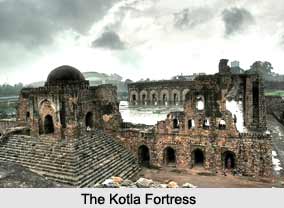 The Feroz Shah Kotla was built by Sultan Feroz Shah Tughlaq to house his version of Delhi city called Ferozabad. Firoz Shah built Feroz Shah Kotla by the banks of the Yamuna River, where he could feel the cool breeze from the mountains and the river. It is a beautiful sandstone pillar built in the 3rd century B.C.
The Feroz Shah Kotla was built by Sultan Feroz Shah Tughlaq to house his version of Delhi city called Ferozabad. Firoz Shah built Feroz Shah Kotla by the banks of the Yamuna River, where he could feel the cool breeze from the mountains and the river. It is a beautiful sandstone pillar built in the 3rd century B.C.
Location of Feroz Shah Kotla
Feroz Shah Kotla is located near Bahadur Shah Zafar Marg in between New Delhi and Old Delhi. In 1354, Sultan Feroz Shah Tughlaq established Ferozabad and Feroz Shah Kotla is the core of that extensive city.
History of Feroz Shah Kotla
The fortified city of Firozabad was established by Firoz Shah Tughlaq (1351-88), the Sultan of Delhi. It was new capital of Delhi Sultanate. Thus, one can see the remains of the fifth city of Delhi, Firozabad, at the Feroz Shah Kotla.
The ruins of a well and a Masjid are also visible at the fort. Feroz Shah Tughlaq also erected the Lat or Ashoka Column that was ascribed to Mauryan ruler Ashoka. Feroz Shah Kotla is a 13.1 metres high column that has been made of polished sandstone. It has been brought from Ambala by Feroz Shah. The fort stands as a testimony to the history of the city of Ferozabad. The ruins of this place were used for the construction of later cities. Feroz Shah was a great builder hence the city was laid with beautiful palaces, mosques and gardens. The Feroz Shah Kotla stands on the uppermost section of a three tiered arcaded palace. The area of Tughlaqabad was facing the problem of water crisis. This forced the Mughals to shift to a prosperous place in Mehrauli. However, as shifting the complete province so far was not possible, Feroz Shah built a new city of Ferozabad on the banks of Yamuna River to solve the problem of water scarcity. The famous fort of Kotla was the inner core fort of Ferozabad which was constructed like a Windsor. It was dotted with many attractive palaces, madrasa as well as Masjids that enhanced the beauty of the city. Later these palaces were destroyed by the Mughals and reduced to mere ruins. The pyramidal structure with the Ashokan Pillar brought from Topra can be seen here. A three tiered baoli is also visible here. The city of Delhi was also destroyed by the invasion of Timur. Kotla was later used as a citadel by the Saiyyads and Lodi dynasty.
Structure of Feroz Shah Kotla
It is a three-storey building which was especially commissioned by Feroz Shah to support the Ashoka pillar. This pillar was set up at Topra, near Ambala, by the great Mauryan Emperor Ashoka. The pillar had several edicts regarding Ashoka`s principles of government inscribed on it. This monolith pillar is 13 metres high, with a diameter of 65cms at the top and 97cms at the bottom. Feroz Shah ordered to bring it to Delhi and it was reinstalled here with great effort. It was crowned by a capital of coloured stones and a golden globe with a crescent on top. The building, now in ruins, originally has a railing and eight domed chhatris (pillared kiosks) at the top, and a stone lion at each corner.
Ruins of Feroz Shah Kotla Palace
The walls of the citadel are as high as 15 metres high and have a slight slope on the outside. The top parapets or merlons have now disappeared but the arrow slits can still be seen. Historians have listed many structures in the fortress. One of them was, `The Palace of the Wooden Gallery/Overhang` was for the officers of the emperor, and the `Central Quadrangle` or the `Palace of the Public Court`, was where the emperor held court for the general public. The surfaces were at one time covered by a fine limestone plaster which was decorated by carving and painting in various colours.
During the pre independence era as there were no auditoriums in the capital Feroz Shah Kotla was the host to most of the classical music performances. Later Ebrahim Alkazi, then head of NSD, conducted his landmark production of Dharamvir Bharati`s Andha Yug here. Its premiere held in 1964 was attended by Prime Minister Jawaharlal Nehru.
Presently the Feroz shah Kotla cricket stadium is famous for its historical cricket matches and the great stadium facilities at Delhi. It is here that the Indian bowler Anil Kumble took his 10 wickets.






